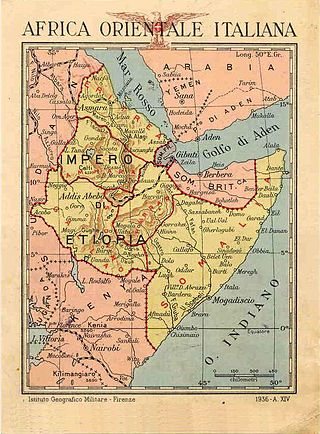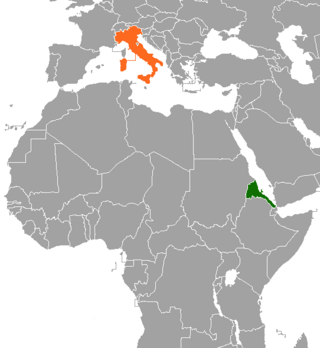Related Research Articles

Asmara, or Asmera, is the capital and most populous city of Eritrea, in the country's Central Region. It sits at an elevation of 2,325 metres (7,628 ft), making it the sixth highest capital in the world by altitude and the second highest capital in Africa. The city is located at the tip of an escarpment that is both the northwestern edge of the Eritrean Highlands and the Great Rift Valley in neighbouring Ethiopia. In 2017, the city was declared as a UNESCO World Heritage Site for its well-preserved modernist architecture. According to local traditions, the city was founded after four separate villages unified to live together peacefully after long periods of conflict. Asmara had long been overshadowed by nearby Debarwa, the residence of the Bahr Negash or the governor of the coastal province, however it still existed as a major settlement for over half a millennium and enjoyed some importance as it stood on the trade route to Massawa. Asmara first rose to prominence during the 20th century, when it became capital of Italian Eritrea. Under Italian rule the city of Asmara experienced rapid urbanization and modernization.

Renato Carosone was an Italian musician.

Education in Eritrea is officially compulsory between 7 and 16 years of age. Important goals of Eritrea's educational policy are to provide basic education in each of Eritrea's mother tongues as well as to produce a society that is equipped with the necessary skills to function with a culture of self-reliance in the modern economy. The education infrastructure is currently inadequate to meet these needs.

The Church of Our Lady of the Rosary, Asmara is a Catholic church built in the early 1920s in Asmara, when the city was the capital of Italian Eritrea. Often called "the cathedral", it is a large Lombard Romanesque style church in the centre of the city, built in 1923 to serve as the principal church of the Apostolic Vicariate of Eritrea.
Football is the most popular sport in Eritrea. After being under Ethiopian control, Eritrea gained its independence in 1991 and in 1998 the country became a member of FIFA.

Italian Eritreans are Eritrean-born citizens who are fully or partially of Italian descent, whose ancestors were Italians who emigrated to Eritrea during the Italian diaspora, or Italian-born people in Eritrea.

The Royal Corps Of Eritrean Colonial Troops were indigenous soldiers from Eritrea, who were enrolled as askaris in the Royal Corps of Colonial Troops of the Royal Italian Army during the period 1889–1941.

Bands was an Italian military term for irregular forces, composed of natives, with Italian officers and NCOs in command. These units were employed by the Italian Army as auxiliaries to the regular national and colonial military forces. They were also known to the British colonial forces as "armed Bands".

Zerai Deres was an Eritrean translator and patriotic revolutionary. In 1938, he engaged in an act of public devotion to an important symbol of his native country, the Monument to the Lion of Judah, at the time kept in Rome. When interrupted, he violently protested against Italian colonialism while brandishing a scimitar, which led to his arrest and internment in a psychiatric hospital for seven years, until his death. However, contemporary Italian historians doubt the claim that he was mentally unstable. Zerai's protest, lionized after the end of the Second World War, is considered by Eritrean and Ethiopian historiography as part of the movement against Italian occupation. To this day, Zerai is considered a legend and a folk hero of anticolonialism and antifascism both in Eritrea and Ethiopia.

Italian Eritrea was a colony of the Kingdom of Italy in the territory of present-day Eritrea. The first Italian establishment in the area was the purchase of Assab by the Rubattino Shipping Company in 1869, which came under government control in 1882. Occupation of Massawa in 1885 and the subsequent expansion of territory would gradually engulf the region and in 1889 borders with the Ethiopian Empire were defined in the Treaty of Wuchale. In 1890 the Colony of Eritrea was officially founded.

Eritrea Governorate was one of the six governorates of Italian East Africa. Its capital was Asmara. It was formed from the previously separate colony of Italian Eritrea, which was enlarged with parts of the conquered Ethiopian Empire following the Second Italo-Ethiopian War.
Riccardo Astuto di Lucchese was an Italian diplomat and writer. He was born in Naples. He was the Italian colonial governor of Eritrea for five years, from 1930 to 1935.

Asmara, the capital of Eritrea, first rose to prominence in medieval and post-medieval times. Though it had long overshadowed by nearby Debarwa, the residence of the Bahr Negash or the governor of the coastal province, it still existed as a major settlement for over half a millennium and enjoyed some importance as it stood on the trade route to Massawa. During the 20th century it was a staging ground for Italian initiatives in East Africa, collateral of Britain's colonial politics, and the subject of the expansion of Ethiopia until 1993, when the sovereign state of Eritrea was established. Despite the passage of over seventy years, the city has remained mostly unchanged in structural design, likely influenced by its position as a UNESCO World Heritage Site.

The Mogadiscio Circuit was formerly a car race through the main streets of Mogadiscio, Italian Somaliland, being first run in 1938.
The following is a timeline of the history of the city of Asmara, Eritrea. Asmara was under Italian colonial rule from 1889 until 1941.
Nenne Sanguineti Poggi (1909–2012) was an Italian painter. She is best known for her public artworks in Eritrea and Ethiopia, and her commissions for Emperor Haile Selassie.

The Imperial Line was a flight route of the Italian national airline Ala Littoria between 1935 and 1941 during the Fascist era. It was the longest route in the Italian colonial empire in Africa and "the jewel in Ala Littoria's crown". It connected Rome with Benghazi (Libya), Asmara (Eritrea), Addis Abeba (Ethiopia) and Mogadishu (Somalia). It carried passengers and mail. Italy ultimately lost control of the route during World War II.

The Petrella Airport was the first international airport in Italian Somalia. It was opened in 1928 -just 3 miles south of Mogadishu- with the name "Enrico Petrella" in honor of an Italian pilot who died a few years before in the same airport of Italian Mogadiscio. In 1941 the airport was partially destroyed during WW2 and remained inactive for some years as a civilian airport: only military airplanes used it. In 1950 was reopened as a civilian airport by the Italian authorities of the ONU Fiduciary Mandate.

Eritrea–Italy relations are the bilateral relations between Italy and Eritrea. Both nations are members of the United Nations.

The history of cinema in Eritrea dates back to the country's colonial rule under the Kingdom of Italy. In connection with the growth of Italian cinema in the 1930s, so too did the rise of cinema occur in Asmara, Eritrea. In 1937, Asmara's Opera was converted into a dual-use theatre and cinema. By the following year, Asmara had a total of nine movie theatres.
References
- 1 2 "Erminia Dell'Oro: "Così racconto nelle scuole i piccoli migranti"". Corriere della Sera (in Italian). Retrieved 15 November 2017.
- ↑ Marchese, R. "Uno sguardo sul colonialismo italiano: Gli scritti di erminia dell'oro". Ajol. Retrieved 17 July 2022.
- ↑ "From ABANDONMENT: AN ERITREAN STORY". Euro Lit Network. Retrieved 17 July 2022.
- 1 2 3 "Erminia Dell'Oro". www.encyclopediaofafroeuropeanstudies.eu (in Italian). Archived from the original on 8 December 2015. Retrieved 15 November 2017.
- ↑ Ponzanesi, Sandra (2004). Paradoxes of postcolonial culture : contemporary women writers of the Indian and Afro-Italian diaspora. Albany: State University of New York Press. ISBN 1423740076. OCLC 62395526.
- ↑ Boca, Angelo Del (11 March 2015). La nostra Africa (in Italian). Neri Pozza Editore. ISBN 9788854509894.